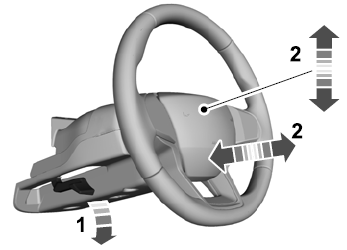Lincoln Aviator: Starting System - 3.0L EcoBoost / Description and Operation - Starting System - System Operation and Component Description
System Operation
System Diagram
.jpg)
| Item | Description |
|---|---|
| 1 | PCM |
| 2 | Starter relay |
| 3 | Starter motor |
| 4 | BCM |
| 5 | Automatic transmission |
| 6 | Ignition switch |
Network Message Chart
Module Network Input Messages Powertrain Control Module (PCM)
| Broadcast Message | Originating Module | Message Purpose |
|---|---|---|
| Ignition status | BCM | Provides the PCM with ignition mode. |
Starting System
The BCM controls the ignition modes and, in conjunction with the PCM, the starting system.
During a start event, when the ignition switch is turned to Start (without push button start) or the engine start/stop switch and the brake pedal are pressed simultaneously (with push-button start), the PCM and BCM receive a request to start the engine. The PCM recognizes the correct inputs from the BCM and TR sensor and provides voltage and ground to energize the starter relay coil and close the starter relay contacts. The starter relay contacts close, providing voltage to the starter solenoid, allowing the starter motor to crank the engine. The PCM disengages the starter motor once an engine RPM threshold is reached, a set crank time is exceeded or the ignition switch is turned to off (without push button start) or the start/stop button is pressed (with push-button start).
Passive Anti-theft System (PATS)
This vehicle may be equipped with PATS. PATS disables the engine from starting if an unprogrammed PATS key is used or an invalid PCM ID is received. The PATS is controlled by the BCM. If there is a PATS concern that disables the engine, the IPC displays a corresponding message in the message center.
Refer to: Passive Anti-Theft System (PATS) - System Operation and Component Description (419-01B Passive Anti-Theft System (PATS), Description and Operation).
(without Push Button Start) or
Refer to: Passive Anti-Theft System (PATS) - System Operation and Component Description (419-01B Passive Anti-Theft System (PATS), Description and Operation).
(with Push Button Start)
Remote Start
The remote start system is controlled by the RKE system. For more information,
Refer to: Handles, Locks, Latches and Entry Systems - System Operation and Component Description (501-14 Handles, Locks, Latches and Entry Systems, Description and Operation).
Component Description
Body Control Module (BCM)
Refer to: Module Controlled Functions - Component Location (419-10 Multifunction Electronic Modules, Description and Operation).
Ignition Switch (without Push Button Start)
Refer to: Steering Wheel and Column Electrical Components - System Operation and Component Description (211-05 Steering Wheel and Column Electrical Components, Description and Operation).
Ignition Switch - Push Button Start (with Push Button Start)
The ignition switch - push button start (engine start/stop button) is a momentary contact switch that is hardwired to the BCM and the PCM. The ignition switch - push button start is used to obtain the OFF, ON or START ignition modes. For more information,
Refer to: Steering Wheel and Column Electrical Components - System Operation and Component Description (211-05 Steering Wheel and Column Electrical Components, Description and Operation).
Integrated Keyhead Transmitter (IKT) (without Push Button Start)
Refer to: Passive Anti-Theft System (PATS) - System Operation and Component Description (419-01B Passive Anti-Theft System (PATS), Description and Operation).
Passive Key (with Push Button Start)
Refer to: Passive Anti-Theft System (PATS) - System Operation and Component Description (419-01B Passive Anti-Theft System (PATS), Description and Operation).
Passive Anti-Theft Transceiver
Refer to: Passive Anti-Theft System (PATS) - System Operation and Component Description (419-01B Passive Anti-Theft System (PATS), Description and Operation).
Powertrain Control Module (PCM)
The PCM provides power and ground to the starter relay to initiate cranking of the engine.
RTM
Refer to: Handles, Locks, Latches and Entry Systems - System Operation and Component Description (501-14 Handles, Locks, Latches and Entry Systems, Description and Operation).
 Description and Operation - Starting System - Overview
Description and Operation - Starting System - Overview
Starting System
The starting system controls the cranking of the engine. The PCM energizes the starter relay when it receives inputs from the ignition switch, automatic transmission, and the BCM...
 Diagnosis and Testing - Starting System - 3.0L EcoBoost
Diagnosis and Testing - Starting System - 3.0L EcoBoost
Diagnostic Trouble Code (DTC) Chart
Diagnostics in this manual assume a certain skill level and knowledge of Ford-specific diagnostic practices.REFER to: Diagnostic Methods (100-00 General Information, Description and Operation)...
Other information:
Lincoln Aviator 2020-2026 Service Manual: Description and Operation - Front Seats - Overview
Overview Driver Power Seat The driver power seat is available with a 10, 12 or 30-way power adjustable memory seat. The driver power seat is controlled by the DSM located on the driver seat track. PMI is required when a new DSM is installed. The DSM hard stop/soft stops must be set/reset any time a new DSM, driver seat track, horizontal motor, driver seat backrest, cushion extension assembly (30-way only) or headrest assembly (30-way only) is installed...
Lincoln Aviator 2020-2026 Owners Manual: Cruise Control - Vehicles With: Cruise Control
..
Categories
- Manuals Home
- Lincoln Aviator Owners Manual
- Lincoln Aviator Service Manual
- Wireless Accessory Charger (If Equipped)
- Body and Paint
- Disabling Auto-Start-Stop
- New on site
- Most important about car
Adjusting the Steering Wheel - Vehicles With: Manual Adjustable Steering Column
WARNING: Do not adjust the steering wheel when your vehicle is moving.
Note: Make sure that you are sitting in the correct position.
Unlock the steering column. Adjust the steering wheel to the desired position.

.jpg)